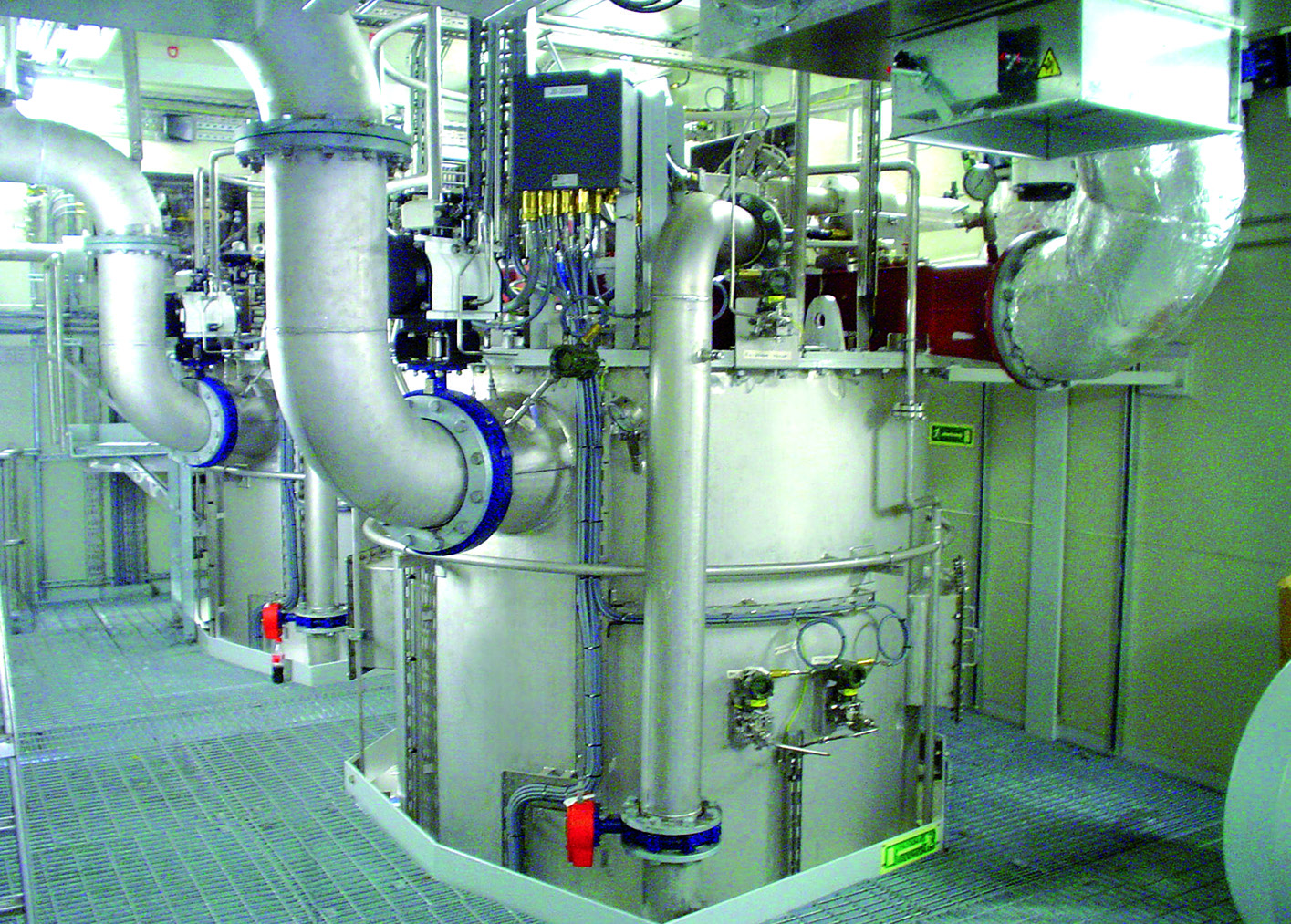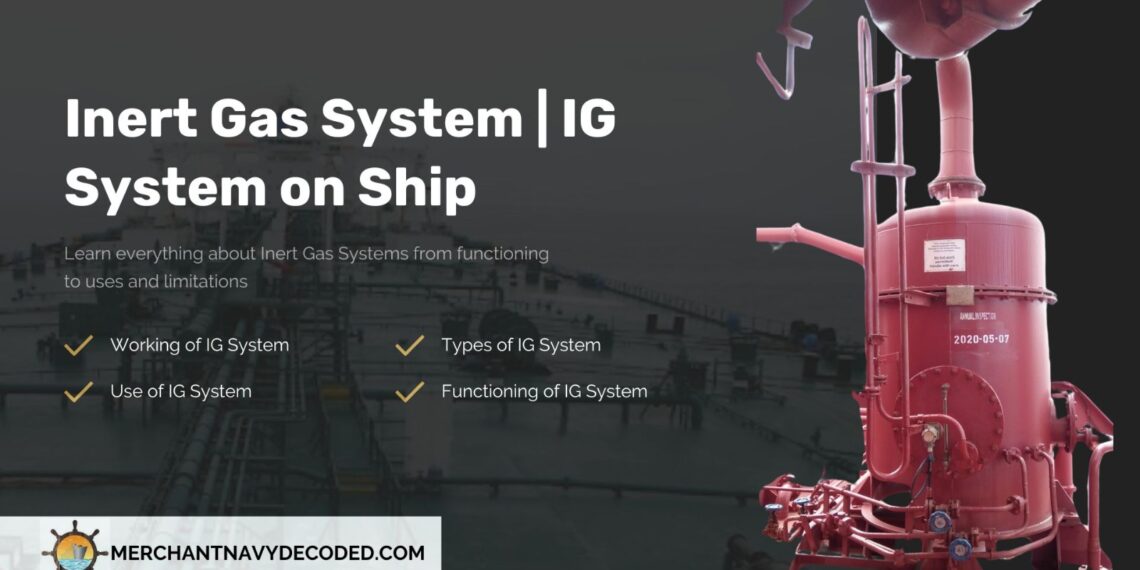Inert Gas System
Table of contents
Overview
Inert Gas Systems (IGS) are vital safety mechanisms on oil vessels, displacing flammable gases with inert ones to prevent explosions. They consist of generators, scrubbers, blowers, and safety features, ensuring compliance with international regulations. Different types offer efficiency and control options, crucial for maritime safety and environmental protection.
1. What is Inert Gas System
Inert Gas System or IG system are among one of the most crucial safety and security functions of oil vessels. They assist protect against explosion by filling out vacant cargo containers with nitrogen which displaces flammable gases. This minimizes the danger of ignition, minimizes cargo contamination together and shields the storage tank’s structural integrity.

2. How Does an Inert Gas System Works
Step 1: Boiler Uptake: The ship’s boilers produce inert gas by burning fuel. The combustion gases, notably nitrogen, and carbon dioxide, are collected from the boiler uptakes.
Step 2: Scrubbers: The collected gases are sent through scrubbers to remove any remaining sulphur and other pollutants. Scrubbers also cool the gases to the necessary temperature.
Step 3: IG Blowers: Following scrubbing, the inert gas is compressed using IG blowers to guarantee adequate distribution throughout the cargo tanks. To prevent air from entering the cargo tanks, the blowers maintain the proper pressure.
Step 4: Oxygen Analyzer: An oxygen analyser continuously analyses the inert gas to verify that its oxygen content remains below the required level (typically 8% by volume).If the oxygen level climbs beyond the predetermined limit, it signals a system leak or malfunction, triggering alarms and repair procedures.
Step 5: Fresh Air Intake: Inert gas is not used indefinitely; fresh air intake is required for crew safety and comfort. Fresh air is supplied into the system to replace the inert gas once cargo activities are completed or during tank cleaning.
Step 6: Deck Seal: A deck seal, which is frequently found at the top of cargo tanks, prevents inert gas from escaping and keeps the tanks at the proper pressure. The seal ensures that no air enters the cargo tanks, reducing the risk of cargo oxidation or explosion.
Step 7: PV Breaker valve: The PV (Pressure Vacuum) breaker valve acts as a safety measure, preventing over-pressurization or vacuum collapse within the cargo tanks. It automatically opens and closes to moderate pressure changes, ensuring the tanks’ integrity.
Step 8: Backflow valve: The backflow stop valve in the inert gas piping system prevents inert gas from flowing back into machinery spaces. It ensures that inert gas generated during cargo operations is only directed toward cargo tanks.
Step 9: Master Riser: The master riser is an essential part of the inert gas distribution system, linking the IG blowers to the cargo tanks. It allows for the regulated flow of inert gas into the different tanks, resulting in uniform distribution.
3. Components of Inert Gas System
The components of an inert gas system in ships typically include:
1. Inert Gas Generator: This is the heart of the system, responsible for producing inert gas, usually nitrogen, onboard the ship. The generator can use various methods such as burning fuel oil or utilizing a membrane system to separate nitrogen from the air.
2. Gas Scrubber: The gas scrubber removes impurities from the inert gas produced by the generator, ensuring that the gas injected into the cargo tanks meets purity requirements and is free from contaminants.
3. Deck Seal: A deck seal is installed at the interface between the inert gas piping system and the cargo tank to prevent the escape of inert gas and maintain the inert atmosphere within the tank.
4. Inert Gas Piping System: This system consists of pipes and valves that distribute the inert gas from the generator to the cargo tanks. It ensures that the inert gas is effectively delivered to the desired locations within the ship’s cargo spaces.
5. Pressure and Temperature Sensors: These sensors monitor the pressure and temperature levels within the cargo tanks and the inert gas system, providing crucial feedback to ensure safe and efficient operation.
6. Control Panel: The control panel is the interface through which operators monitor and control the operation of the inert gas system. It allows for adjustments to be made to gas production, distribution, and monitoring parameters as needed.
7. Safety Features: Various safety features are incorporated into inert gas systems, including emergency shutdown systems, gas detection systems, and pressure relief valves, to prevent overpressure situations and ensure safe operation under all conditions.
These components work together seamlessly to create and maintain an inert atmosphere within the cargo tanks, thereby minimizing the risk of explosions and fires during the transportation of flammable cargo at sea.
4. Types of Inert Gas Systems
4.1:- Flue Gas Inert Gas System:
A flue gas system uses the exhaust gas from the ship’s boilers (flue gas) as an inert gas source. Flue gases are cleaned and cooled before they are injected into cargo tanks. A flue gas system is a simple and inexpensive solution for older vessels.
4.2:- Nitrogen Inert Gas System:
Nitrogen inert gas systems produce inert gas by separating nitrogen from the air using a membrane or cryogenic process. The nitrogen is then infused right into the cargo containers to develop an inert environment. Nitrogen systems offer greater control and purity of the inert gas and are commonly used in modern vessels.
4.3:- Membrane Inert Gas System:
This system uses a semi-permeable membrane to separate nitrogen from the air. The nitrogen produced is then injected into the cargo tanks. Membrane systems are compact, lightweight, and energy-efficient, making them suitable for smaller vessels.
Check out our dedicated course on Inert gas system and gain in-depth knowledge about IG system on ship.
5. Safety Considerations of Inert Gas System
Safety considerations are paramount when operating Inert Gas Systems in ships.
- Gas Monitoring: Continuous monitoring of inert gas levels, oxygen concentrations, pressure, and temperature within cargo tanks is important to ensure the system operates within safe parameters.
- Leak Detection: Regular inspection and testing of inert gas piping systems and deck seals are necessary to detect and address any leaks that could compromise the effectiveness of the system.
- Emergency Shutdown: Inert gas systems should be equipped with emergency shutdown mechanisms to quickly stop gas flow in case of malfunction or safety hazard.
- Fire prevention: while inert gas systems are designed to prevent fires, it’s important to maintain fire prevention measures such as proper tank cleaning, ventilation, and compliance with hazardous cargo handling procedures.
- Regulatory Compliance: Inert gas systems must comply with international regulations and standards set forth by the International Maritime Organization to ensure their design, installation, and operation meet safety requirements.
Check out our comprehensive guide on Oily Water Separator.
6. Regulatory Requirements for Inert Gas System
The regulatory requirements for inert gas systems in ships are primarily governed by international maritime conventions and standards established by organizations such as the International Maritime Organization (IMO). Key regulatory requirements include:
- SOLAS Convention: The International Convention for the Safety of Life at Sea (SOLAS) sets out minimum safety standards for the construction, equipment, and operation of ships. Chapter II-2 of SOLAS specifically addresses fire protection, including requirements for inert gas systems on oil tankers and other vessels carrying flammable cargoes.
- IGC Code: The International Code for the Construction and Equipment of Ships Carrying Liquefied Gases in Bulk (IGC Code) provides detailed requirements for the design, construction, and operation of ships carrying liquefied gases, including inert gas systems. The IGC Code supplements SOLAS requirements and includes specific provisions for inert gas systems on gas carriers.
- IBC Code: The International Code for the Construction and Equipment of Ships Carrying Dangerous Chemicals in Bulk (IBC Code) contains requirements for the design and construction of ships carrying dangerous chemicals in bulk, including provisions related to inert gas systems for chemical tankers.
- Classification Society Rules: Classification societies such as Lloyd’s Register, DNV GL, and ABS issue rules and standards that ships must comply with to obtain class certification. These rules often include requirements for inert gas systems based on SOLAS, IGC Code, and IBC Code requirements.
- Flag State Regulations: Each flag state may have its regulations and requirements related to inert gas systems, which ships registered under that flag must adhere to.
- Port State Control: Ships are subject to inspection by port state control authorities to ensure compliance with international regulations and standards. Inert gas systems are among the critical systems inspected during port state control examinations.
Compliance with these regulatory requirements is essential to ensure the safe operation of inert gas systems and to prevent accidents involving the transportation of hazardous cargo at sea.
Conclusion
In conclusion, Inert Gas Systems is a critical component of marine safety, especially for vessels transporting flammable and dangerous goods. By displacing oxygen with inert gas, these systems successfully reduce the risk of explosion and fires in cargo tanks, protecting vessels, crew members, and the marine environment. The history of inert gas systems, from early flue gas systems to modern nitrogen and membrane systems, demonstrates a proactive commitment to improving maritime safety. Advances in technology, materials, and regulatory standards have all helped to make inert gas systems more efficient, dependable, and ecologically friendly. While inert gas systems play an important role in reducing maritime mishaps, their success is ultimately dependent on correct design, installation, operation, and maintenance.
Disclaimer :- The opinions expressed in this article belong solely to the author and may not necessarily reflect those of Merchant Navy Decoded. We cannot guarantee the accuracy of the information provided and disclaim any responsibility for it. Data and visuals used are sourced from publicly available information and may not be authenticated by any regulatory body. Reviews and comments appearing on our blogs represent the opinions of individuals and do not necessarily reflect the views of Merchant Navy Decoded. We are not responsible for any loss or damage resulting from reliance on these reviews or comments.
Reproduction, copying, sharing, or use of the article or images in any form is strictly prohibited without prior permission from both the author and Merchant Navy Decoded.



